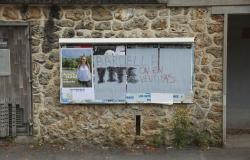The Israeli army concentrated its operations against the Palestinian Islamist movement Hamas on Sunday in the cities of Gaza and Rafah. Prime Minister Benjamin Netanyahu spoke to him of a “difficult fight”.
Nearly nine months into the war, sparked by an unprecedented Hamas attack on Israel on October 7, Netanyahu says he wants to continue it until the Palestinian movement in Gaza is eliminated and all hostages taken during the attack are released.
This war, which caused a humanitarian catastrophe in the besieged and devastated Palestinian territory, also raises fears of a conflict between Israel and Lebanese Hezbollah after an increase in attacks on both sides of the Israeli-Lebanese border.
Gaza City targeted
In the last 24 hours, 43 Palestinians have been killed in the Israeli offensive against the Gaza Strip, the Health Ministry of the Hamas government which took power in the Palestinian territory in 2007 said on Sunday.
According to witnesses, numerous Israeli airstrikes targeted Gaza City in the north, as well as Rafah and Khan Younis in the south.
While the army announced in January that it had dismantled Hamas’s command structure in the north of the territory, its soldiers launched an operation on Thursday in Shujaiya, a district of Gaza City, under air cover and artillery. Bombings and fighting continued on Sunday for the 4th consecutive day.
Between 60,000 and 80,000 people, according to the UN, fled the east and northeast of Gaza City after the army ordered them to evacuate on Thursday.
In southern Gaza, Israeli troops launched a ground offensive on May 7 in the city of Rafah, then touted by Israel as Hamas’ last major stronghold. Six people were killed in a strike that hit a house in Rafah and artillery fire rocked parts of the city, witnesses and medics said.
“Underground Combat”
“Our forces are operating in Rafah, Shujaiya, throughout the Gaza Strip,” Benjamin Netanyahu declared on Sunday at the weekly government meeting, a week after asserting that “the intense phase” of the war was coming to an end.
“Dozens of terrorists are eliminated every day. It is a difficult fight that we are waging on the ground, sometimes hand-to-hand, and also underground,” he said, referring to the tunnels dug underground by Hamas. during his years in power.
The attack carried out by Hamas on October 7 in southern Israel resulted in the deaths of 1,195 people, mainly civilians, according to an AFP count based on official Israeli data. Of 251 people kidnapped during the attack, 116 are still held hostage in Gaza, among whom 42 are dead, according to the army.
The offensive launched by Israel in retaliation on the small Palestinian territory has so far left 37,877 dead, mostly civilians, according to data from the Health Ministry of the Hamas-led Gaza government.
Attacks by Israel and Hezbollah
The war has caused massive population displacements in the territory where some 2.4 million people are under siege in conditions described as “disastrous” by the UN.
Humanitarian aid is arriving in dribs and drabs and there is a shortage of water and food. Thousands of children are suffering from malnutrition, according to the World Health Organization (WHO), which in mid-June reported “32 deaths attributed to malnutrition, including 28 among children under five.”
Fears of the conflict spreading to Lebanon have recently increased. On June 19, Hassan Nasrallah, the leader of Hezbollah, a powerful movement allied with Hamas and backed by Iran, warned “no place” in Israel would be spared in the event of war, after the army claimed having “validated” “operational plans” for an offensive in Lebanon.
On Sunday, Hezbollah claimed new attacks against Israeli military positions on the border, while Lebanese media reported Israeli bombings on southern Lebanon.
This article was published automatically. Sources: ats / afp





